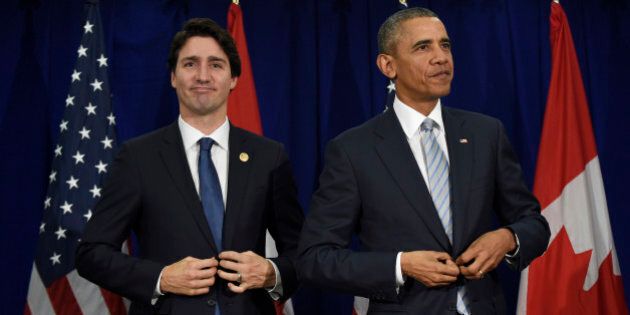
During a panel discussion in which I participated last week in Washington D.C. on Prime Minister's Trudeau's upcoming visit, I couldn't help but think back to June when, as noted in HuffPost, the PM was the only candidate to devote substantial time to the relationship. That was more than just a signal for the Trudeau campaign; it was a good indicator of how we wound up with a state dinner and a suddenly brighter future for North America.
During the talk in D.C., it was clear that amongst the lobbyist and government relations crowd at the talk, there appeared to be a heightened sense of anticipation for this visit; above what one would normally expect for a run of the mill head of state visit.
The difference with this visit seems partially to be pent up demand. In addition to the usual, 'clean slate' with a new head of state, it's been a while since we've had a visit by a Canadian PM where anyone expected something productive to come from the meeting.
There was also a widespread sense that this window of opportunity, that is now suddenly wide open, has a short shelf life of at best 315 days until Obama leaves office.
And this is good news for Canada with Trudeau as PM.
We have a US president who is well into thinking about his legacy and who has evinced a remorseless willingness to stick it to the US congress in order to check things off his bucket list. The extreme polarization in D.C. rules out compromise and encourages rather than disciplines the President's willingness to go the executive action route, something that will disappear with a new occupant in the White House. Arguably, the only real brake ln the President's willingness to use executive orders would be worries over hurting democrats running for the Senate or house. Barring that, anything that infuriates the Trump-istas is an action without cost and one that may actually help rile up the democrat's base.
If the PM is still looking for a gift to take to the White House, a nice fountain pen and a few bottles of ink would be appropriate.
This US president, at this point in his trajectory, now suddenly has a potential new ally, fellow traveler, or more succinctly, a potential new 'bestie' to help him out on the now front-and-centre legacy project that is is his final 300 days in office.
That Trudeau has managed to get relations with Mexico back on track makes this change in Canada all the more important for Obama. While having an energy and environment accord with Canada is nice, if one is thinking 'legacy' then a "hemispheric accord" has a much better ring to it. Mexico has been a leader, verbally at least, on climate change issues in North America and the Mexicans have spent the past couple of years waiting for some sing of life and interest in "North American" projects from the other two amigos.
Suddenly, the pieces are falling into place for the upcoming North American leaders summit, which Canada is hosting likely early this summer to matter.
In that regard, the meeting in D.C. may be more of a strategic opportunity to build for the upcoming leaders' summit this summer. The real outcomes from the March D.C. trip may not appear until then.
What else to expect? Why not an agreement on softwood lumber or an extension of the ban on bringing new actions that runs for twelve months after the expiry of the old agreement and is set to run out this fall? While this is something that will not be announced next week the upcoming visit could be an opportunity for quiet assurances about a future pact. The softwood lumber agreement is, after all, another example of an executive action or something where the authority to get it done resides with the President, as I was reminded on my trip to D.C. by a former US official who worked on the last agreement.
A quick sampling of 20 congressional districts that the Southern Pine Forest Association thinks important shows just over half are held by republicans but more interesting only 5 of the 20 appear to be competitive races. The mill operators tend to have ownership on both sides of the border so no votes lost there. But, those who use lumber, workers in the housing and contractor industries, tend to be heavily Latino/Hispanic meaning likely to be democratic. Low prices on lumber means lower prices for housing inputs, which should translate into more demand and more jobs. What was true back during the last softwood dispute is more true today thanks to the huge rise of the US Latino/Hispanic population. In Canada we tend not to realize that every month in the US 50,000 to 60,000 US born Latinos/Hispanics turn eighteen and become eligible to vote. The demographic numbers for Trump supporters, on the other hand, are declining.
The political cost of a new agreement versus potential gains from shoring up and motivating the Latino vote in key swing states such as Nevada would seem to argue decisively in favour of the President going ahead.
A new agreement, aka promoting growth in the home building industry, jobs for Latinos/Hispanics and cheaper homes for everyone, would be an awfully nice message for democratic candidates, and a potential VP candidate from Texas, to have as a key part of their stump speech this fall.
Almost as nice as it would be for the Prime Minister as an addition to his soon-to-be-written "What have I done since getting elected last year" speech.
But, for whatever comes out of this visit and the leaders' summit this summer, the clock is ticking. Once a new president and congress take office it's going to be a while until, or depending on the US election outcome, if, it opens again.
Follow HuffPost Canada Blogs on Facebook